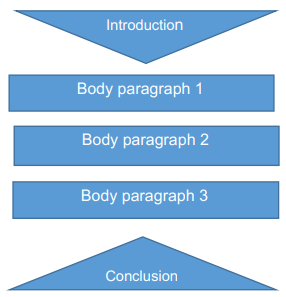6.3: Getting started with organization
- Page ID
- 25401
So, how do you get started? First, consider the overall structure of any piece of writing:
- Introduction
- Body paragraphs
- Conclusion
So that is the basic idea. But let's look at organization more carefully, using the example of an essay as out mode.
Keep in mind as you go through this section that if we were writing a novel, or a movie review, or a manual for work, or an epic poem, there would be different expectations, in many ways. But for the most part, the organizational ideas below go for all modes and genres of writing.
The most basic essay format is the five-paragraph essay. It looks like this:

Note that the introduction is an inverted triangle because traditionally, introductions begin broadly and move to more specific information, ending with the very specific thesis statement. The conclusion, then, goes from the specific essay idea to broader generalizations about the topic.
You may have learned about the five paragraph essay in school before, and you might be comfortable with it, too. That’s great! Now, it’s time to expand on this to create essays of more than five paragraphs. Some essays, like essay questions in a history exam, might only require two paragraphs, while a research paper might require twenty paragraphs.
In general, though, all essays will follow the introduction, body, conclusion structure, but introductions and conclusions may be more than one paragraph, and you may have more than three body paragraphs.


